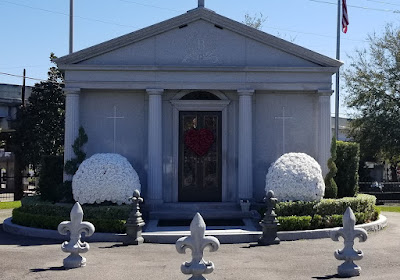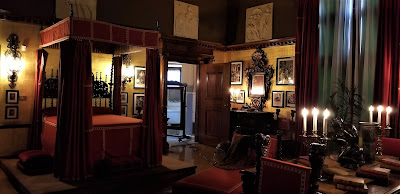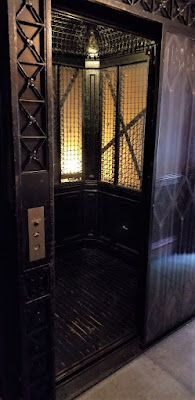Hey Everyone! Welcome back to Day #2 of our 4,000+ mile roadtrip. Today we start off in New Orleans, Louisiana. Not the Mardi Gras, the bars, restaurants, and nightlife party, but the historical, less visited, peaceful attractions. So hop onboard and join us for a geocaching adventure...
We started the day with breakfast, a cache, and a new county at a Waffle House just down the street. We ordered a couple of breakfast bowls to-go. While they were cooking, I grabbed the geocache (GC8MND3) in the parking lot to fill in the blank for St. Charles Parish.
My next county cache was in Jefferson Parish. At the Veterans Memorial Century of Sentries Park, there was a multi-cache hidden here which I could not find the final stage (GC110R8). But it was still a worthy stop. There were many military display's such as the Douglas A-4 Skyhawk Vietnam War attack plane, a 1941 Plymouth Sedan Army staff car, a Vietnam River Patrol boat, a couple of cannons and a torpedo.
Now since I couldn't find that last geocache for the county, I settled on a quick parking lot LPC hide (GC77DYE).
In Orleans Parish, our next stop was the site of the Spanish Fort at Bayou St. John (GC8GC4J). The first small fort here was erected by the French in 1701, before the founding of the city of New Orleans, to protect the important trade route along Bayou St. John. After Louisiana passed to Spanish control, a larger brick fort was constructed at the site of the neglected old French fortification; this was known as San Juan del Bayou. Louisiana passed back to France and then to the hands of the United States. The fort was decommissioned in 1823.
This is the story of the grave at Spanish Fort. During the Spanish days, the Commandant of Fort St. John was Sancho Pablo. He had opened negotiations with the chief of a local Choctaw tribe, Waw-he-wawa (White Goose), who lived down the bayou with his daughter Owaissee (Bluebird). Sometimes Pablo visited the Indian camp and became acquainted with Bluebird as well.
One day, as the legend goes, Bluebird took her canoe down Bayou St. John to the lake. The choppy waters began to pound her canoe until it nearly capsized. Seeing this from the fort, Sancho Pablo ordered his men to prepare a boat at once to rescue her. When they reached her, Pablo personally lifted Bluebird into the Spanish boat to safety and escorted her home. Needless to say, Sancho Pablo and Bluebird fell in love with each other.
Bluebird would paddle down the bayou again and again at night to meet with Sancho.
White Goose became suspicious, however, that his daughter was meeting with this Spaniard; and he became alarmed being strongly opposed to such a relationship. He secretly followed his daughter down the bayou one night and discovered that she was meeting with Pablo. White Goose therefore resolved to kill the Spaniard.
On an ominously dark night, the Indian father traveled down the bayou in a canoe alone.
As the canoe approached the fort in the pitch black night, Pablo believed the boat contained Bluebird coming to visit. Instead the Spaniard soon discovered it was Bluebird's father who came only for blood. White Goose killed Sancho Pablo on the spot.
Legend has it that Pablo's last words were of his eternal love for Bluebird. The soldiers in the fort soon were startled by the sounds of the struggle, but the Indian chief had disappeared. The Spanish soldiers buried the body of their leader on the grounds of the old Spanish Fort. Legend says that the Indian village relocated. Neither Bluebird nor White Goose was ever heard from again.
(https://allpoetry.com/poem/513738-Sancho-Pablo-And-Bluebird-by-Dreamweaver)
(https://allpoetry.com/poem/513738-Sancho-Pablo-And-Bluebird-by-Dreamweaver)
And then, not too far away, was the Milneburg Lighthouse (GC8GC4N). Originally called Port Pontchartrain Lighthouse until 1929. This now landlocked lighthouse was located at the end of Milneburg pier. The brick lighthouse was built in 1855 which replaced the original wooden one which was built in 1832. Milneburg was a small town on the lake shore that was absorbed by New Orleans. The area was connected to the city by Elysian Fields Avenue. In 1830 it was decided to build the region's first railway along the route. The Pontchartrain Rail-Road started steam locomotive which carried people and cargo along the 5 mile trip. The port boomed. Hotels, saloons, bath houses, and resorts were built around it. The importance of Milneburg in shipping declined in the late 19th century, but it remained an important resort. Between 1920s and 1930s new land was reclaimed by dreading the shallows of Lake Pontchartrain which brought the end of old Milneburg.
Unfortunately I didn't get the geocache that was there. It wasn't that I didn't find it, but I didn't get to look. From where I took this photo were two parking spots. We got out of the GeoJeep to walk over for a closer look and to find the cache. Almost immediately, up rolls a golf cart with a security guard telling us that we can't walk out to see the lighthouse because of covid. REALLY? If it were not for the security guard, I'd be able to look completely all around in every direction and NOT see a single person except for my wife and I. I'm pretty sure covid would NOT be an issue. Oh well, off to the next one.
We planned on visiting the most famous of the New Orleans cemeteries, Saint Lewis Cemetery Number 1. With famous permanent residents like voodoo priestess Marie Laveau (1801-1881), civil rights activist Homer Plessy (1862-1925) of the Plessy vs Ferguson Supreme Court case, and future resident and actor Nicholas Cage who already has a 9' tall pyramid placed for his tomb. But it was closed because of... you guessed it... covid.
So we went across the highway to the Metairie Cemetery where we found six of the more than a dozen geocaches hidden there. The Metairie Cemetery Association received its charter in May 1872. This large cemetery was built on a former racetrack, and the oval track shape is still there. Metairie was part of the Rural (Victorian) Cemetery Movement. It’s landscaped and features elements like lakes and wide roads connecting to footpaths.
Interments of note include singer Louis Prima, 49 kings of Carnival, and numerous Louisiana state governors and NOLA mayors.
Just a couple of notable residents here: Thomas Milton Benson (1927-2018), who was the owner of the NFL's New Orleans Saints and the NBA's New Orleans Pelicans.
Josie Arlington was a New Orleans madam whose crypt was once believed to be haunted. It was rumored that the statue of the woman in front of the tomb would come to life and walk the cemetery grounds at night. It was later discovered that a street light reflecting off the tomb gave it a reddish glow, lending credence to the rumors of the haunting. Josie Arlington's body was later moved to an unknown location within the same cemetery.
Located in the center of the Metairie Cemetery is the Tomb of the Army of Northern Virginia. Dedicated on May 10, 1881, the monument was erected in memory to the men of the Division of the Army of Northern Virginia, who served and died in the Civil War. The monument, made of white granite, rises fifty feet above the ground with a statue of General Stonewall Jackson on top and the inscription: "ARMY OF NORTHERN VIRGINIA, LOUISIANA DIVISION," and "FROM MANASSAS TO APPOMATTOX, 1861 TO 1865." Located within the hill below this monument, is a large chamber containing the vaults of many Confederate Officers.
Jefferson Davis, President of the Confederate States, was the unrepentant highest ranking Confederate leader of the South. By the time his peaceful death occurred while visiting New Orleans, he was the symbol of the Lost Cause and the most revered man in the South. Eighteen months after his death and temporary burial in New Orleans Metairie Cemetery, Davis's widow, Varina, decided the final burial place was to be Richmond's Hollywood Cemetery, considered the National Cemetery of the Confederacy.
His remains, were removed from the vault in New Orleans and placed on a flag-draped caisson escorted by honor guards composed of his old soldiers to Memorial Hall, where he lay in state. The next day, as thousands of people silently watched from the sidewalks and balconies, the caisson bore his body to a waiting funeral train. On the way, bonfires beside the tracks lit up ranks of Davis's old soldiers standing at attention beside stacked arms. In Richmond, Gray haired veterans escorted him to the Virginia statehouse where thousands filed past in respect before internment.
Jefferson Davis was the only Southern leader shackled in a dungeon and sacrificed as atonement for the sins of many. He refused to apply for a pardon because, he said, "I have not repented." In 1978, the United States Congress posthumously restored Davis's citizenship.
Driving east into Saint Bernard Parish, we stop for my next county cache at Chalmette Battlefield and National Cemetery (GCA55A). Major General Andrew Jackson's troops were outnumbered and less experienced yet they defended and secured the port of New Orleans from British invasion on January 8, 1815. This victory at the Chalmette Plantation was the last major battle in the War of 1812. The American victory preserved U.S. claims to the Louisiana Purchase territory, prompted settlement in the Mississippi River Valley, made Jackson a national hero, and encouraged American pride and unity.
The construction of a monument honoring Andrew Jackson and his troops was the first step in recognizing the importance of the battlefield and saving it for future generations. In 1852 the Louisiana legislature appropriated funds to purchase land at the battlefield and build a monument there. The project was plagued with funding problems for decades and was finally completed in 1908. In 1939 Chalmette National Historical Park was created and the site became part of the National Park Service.
The destruction of their plantation during the Battle of New Orleans left the de Chalmet family in financial trouble. In 1817, brothers Hilaire and and Louis St. Amand bought the land. The St. Amands were prominent free people of color who already owned several plantations. In the early 1800's, it was not unusual for free people of color to own plantations and slaves in Louisiana. Actually according to the 1860 U.S. census, only 4% of southern whites owned slaves while 28% of freed blacks in New Orleans owned slaves.
The first owner of the Malus-Beauregard House was Madeleine Pannetier Malus, a widow who purchased land from the St. Amand brothers when they divided the land into small tracts in 1832. Malus built a French Colonial house in 1833 or 1834. After her death in 1835, Caroline Fabre Cantrelle bought the house and remolded it to the Greek Revival style it is currently. Its last private owner was Rene Beauregard, son of Confederate General P. T. Beauregard, who purchased it in 1880. The New Orleans Terminal Company then owned the property until 1949, when it became part of the Chalmette National Historical Park.
Looking at the house from the front or the back and you get the impression of an ominous grand estate. In reality, when you look at it from the side, the house is only one room deep with only four rooms on each floor.
The Chalmette National Cemetery was established in 1864 as a burial place for Union soldiers who died in the Gulf area during the Civil War. It also served as a site for reburials of soldiers from battlefield cemeteries in the region. This plot of land was part of the battlefield during the Battle of New Orleans. Only four U.S. veterans of the War of 1812 are buried here. None of the British who died in the battle are buried in the cemetery.
Also located on four acres of the battlefield, is the Freedmen's Cemetery. It was established by the Freedmen's Bureau in 1867, when the bureau received permission to use a portion of the battlefield as a civilian burial ground. The property reverted to other ownership when the bureau was discontinued, and the cemetery gradually fell into ruins. All above ground traces disappeared before the start of the 1900's.
The National Park Service received stewardship of the cemeteries in 1933. There are over 15,000 individuals buried in the 17.5 acre cemetery. Veterans of all major American wars and conflicts are interred here. Of these 15,000, more than 6,700 are unknown. By 1945 all available burial sites were either taken or reserved and the cemetery was closed. It was re-opened briefly in the 1960's for burial of Vietnam Veterans.
There are two burials I wanted to bring to your attention. One is the oldest and belongs to Pvt Elkanah Anderson (1774-1815). Marched from Hickman County Tennessee, then fought and died at the Battle of New Orleans. Mortally wounded in battle on January 8, 1815, then died on January 14, 1815.
The other was Sarah Rosetta Wakeman (1843-1864). Civil War Union Soldier. The oldest child in a poor, large farming family in upstate New York, she left home at nineteen years of age and found she could make more money by dressing as a man and working as a coal handler on a canal boat. Upon learning she could make thirteen dollars a month as a soldier, she disguised herself as a man and enlisted on 30 August 1862 in Montgomery County, New York, as "Lyons Wakeman" in the 153rd New York Volunteer Infantry, Company G which shortly thereafter would be redesignated as Company H. She served until she died of dysentery after fighting in the Battle of Pleasant Hill in Louisiana. Details of her experiences are found in her letters compiled in a book entitled "An Uncommon Soldier" edited by Lauren Cook Burgess. Her total service in the U S Army covered more than one year and seven months.
And finally, our last stop in New Orleans was out of this world (GCB50B). This is the Michoud Assembly Facility for NASA where much of the United States Space Program began. The Saturn 5 booster stage that launched all of the moon missions as well as all of the External Tank for the Space Shuttles were built here. Currently portions of the Orion Capsule slated to take the first men to Mars is being built here.
There used to be two metal sculptures near this virtual geocache location. One is honoring STS 107 which was the Columbia Mission that was lost upon reentry over Texas. The other is dedicated to the Challenger Crew who made the ultimate sacrifice when the shuttle exploded shortly after launching off the coast of Florida.
So that was our tour of New Orleans. Probably NOT the typical sites that most visitors to the "Big Easy" see. Maybe next time when we have longer to stay we'll check out the downtown restaurants and go on a ghost tour or something normal like most tourists. See you next time.
To follow along on our travels and keep up with my latest blogs, you may do so here of course by clicking the "Follow" button to the right. But also by using one or more of your favorite of these social media platforms: Facebook, MeWe, Gab, Reddit, Parlor, Twitter, RVillage, GETTR, Instagram, and TruthSocial. These all link directly to my profiles. Again, please feel free to comment and / or share.









.jpg)



.jpg)


.jpg)





































